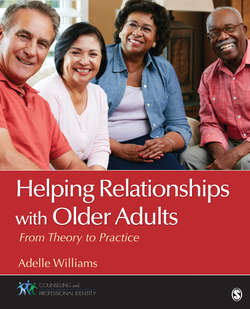Читать книгу Helping Relationships With Older Adults - Adelle M. Williams - Страница 31
На сайте Литреса книга снята с продажи.
Sensation
ОглавлениеChanges in sensation common to older adults include the peripheral nerve function that controls the sense of touch declines slightly with age and the ability to perceive painful stimuli is preserved in aging; however, there may be a slowed reaction time for pulling away from painful stimuli with aging (Cacchione, 2005). Consequences of decreased sensations include the possibility of falls due to inability to recognize position sense or inability to ascertain where feet are on the floor and development of calluses or serious foot lesions. Older adults who fall may develop a fear of falling, which will negatively impact all activities of daily living and social endeavors. Older adults may become anxious and depressed, which may warrant psychological interventions. Mental health practitioners can facilitate coping mechanisms with their older clients, coordinate service providers, provide psychosocial interventions, and facilitate social interaction, which is essential if the older client has become withdrawn.
Sensations may be diminished or changed in older adults. Peripheral nerve function that controls the sense of touch declines slightly with age. Two-point discrimination and vibrating sense both decrease with age. The ability to perceive painful stimuli is preserved in aging; however, there may be a slowed reaction time for pulling away from painful stimuli with aging (Cacchione, 2012). The sense of touch may decrease, and a firmer touch may be needed to elicit a response. Many older adults respond positively to touch; perhaps it indicates a special sense of caring by another person. However, sensations are also compounded by disease, and most older adults will have at least one or more chronic diseases. Diabetic patients will have difficulties in the area of pain sensation. Osteoporosis can produce a sense of being off-balance when ambulating.
The sensation of pain varies considerably in older adults. It may be more difficult to evaluate acute pain because of an older adult’s reduced ability to locate the source of pain. The autonomic response to pain, such as rapid pulse, elevated blood pressure, pallor, and nausea, may not occur in older adults. Every person exhibits learned behaviors in response to pain, and older adults may have experienced chronic discomfort for such a long time that they fail to respond to a new stimulus. Also, the inflammatory response is often reduced or delayed, resulting in a decreased stimulus for pain. A combination of assessment skills to detect the presence of pain is necessary. It is essential to differentiate acute from chronic pain because the cause and treatment may be quite different.
Typically, painful disorders are often less or not at all painful in elders. In the cortex, populations of neurons continuously receive input from upstream neurons, integrate it with their own ongoing activities, and generate output destined for downstream neurons. Such cortical information processing and transmission is limited, and pain sensation appears to decline with age. The brain has a neural (relating to the nervous system) circuit and endogenous (developing from within) substances to modulate pain and as individuals age endogenous pain inhibition is reduced with aging. Some pain thresholds show age-related changes. Although sensitivity to heat pain decreases with age, sensitivity to pressure pain is enhanced. Sensory nerves lose myelin, which is a layer of tissue that surrounds the nerve fibers (axons) selectively, and perhaps predisposing individuals to neuropathy (problem with the nerves). Vibration sensation perception diminishes with aging, especially in the legs (Besdine & Wu, 2008). Changes in sensation may negatively impact older adults and create an unsafe environment, while issues with balance pose similar safety issues within the environment.
